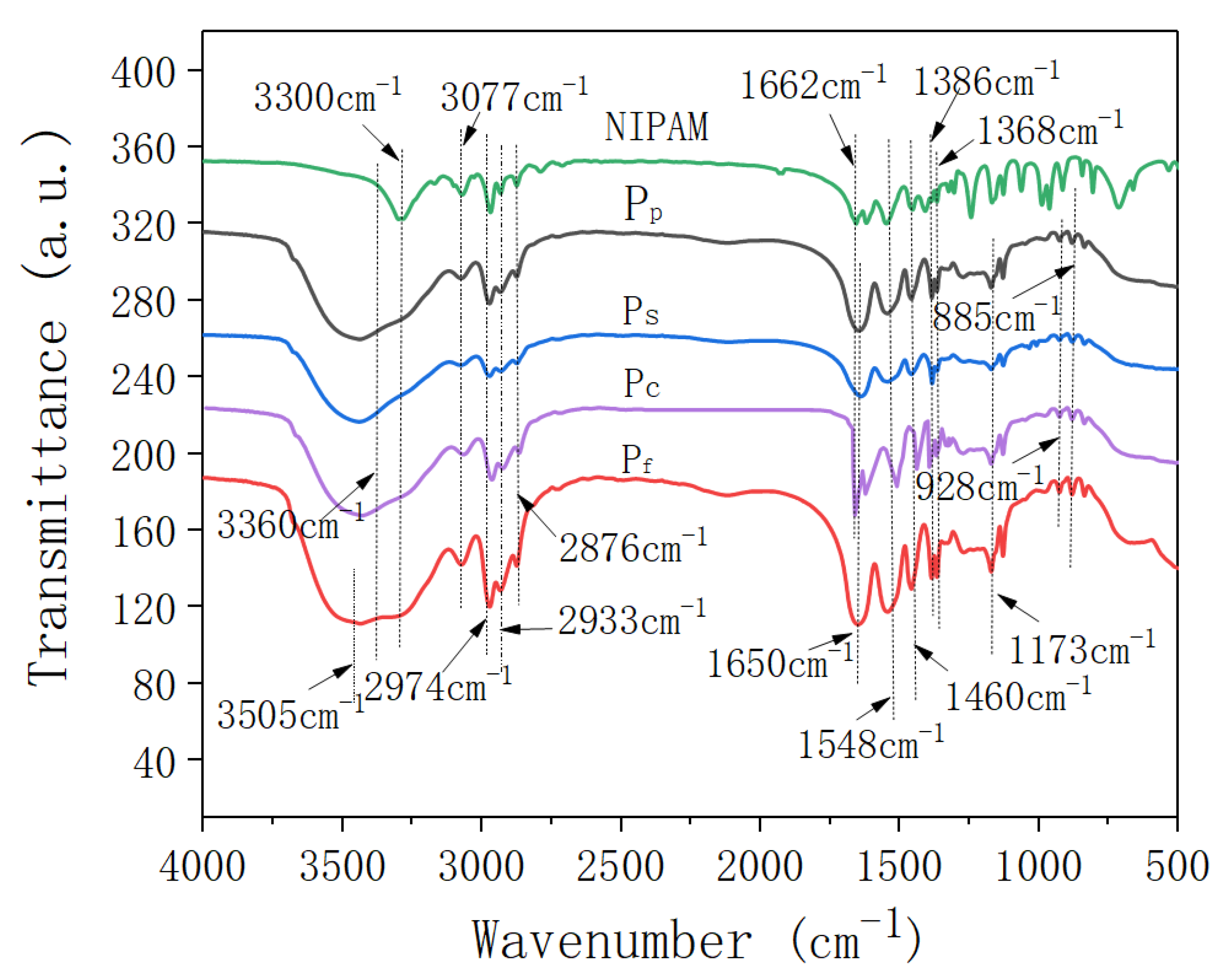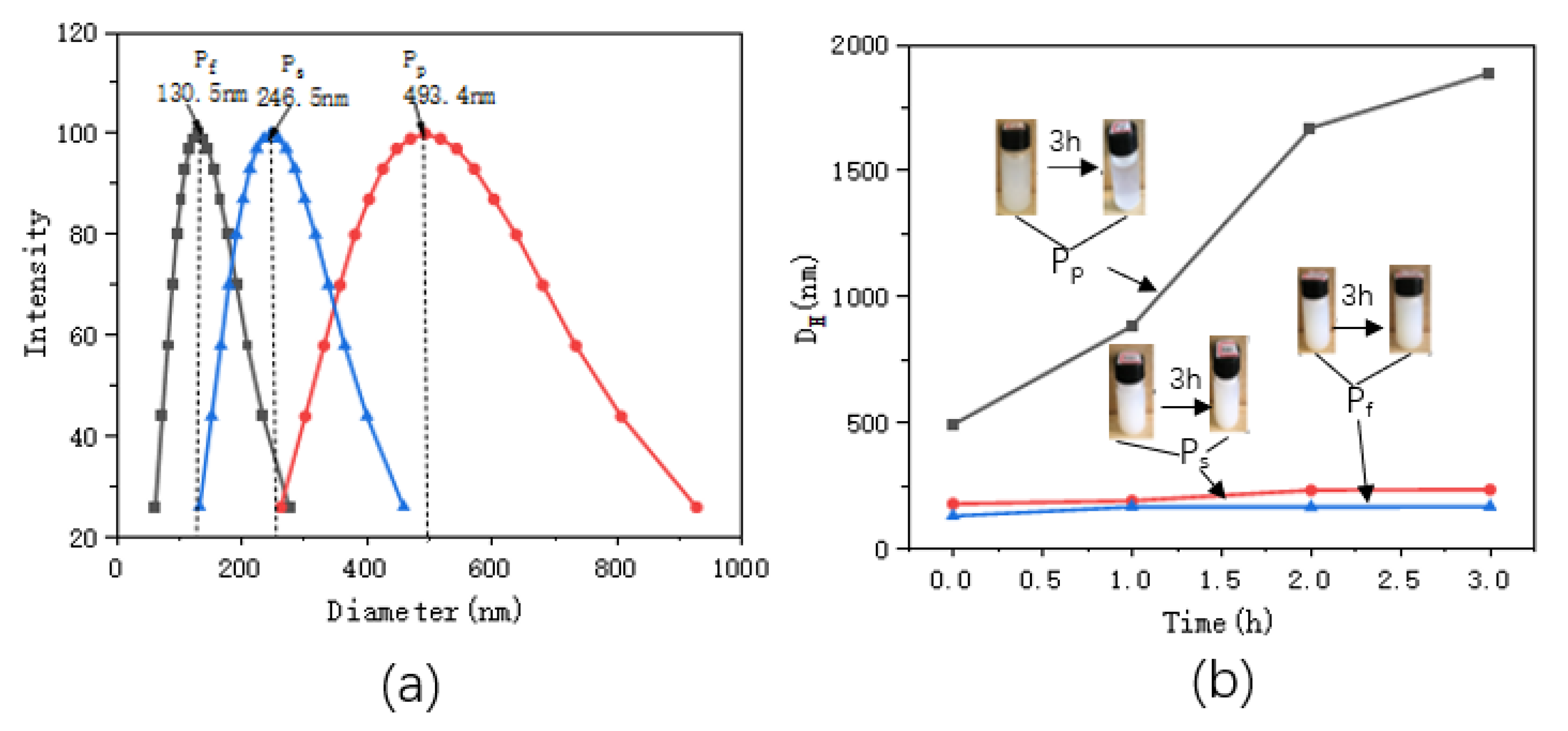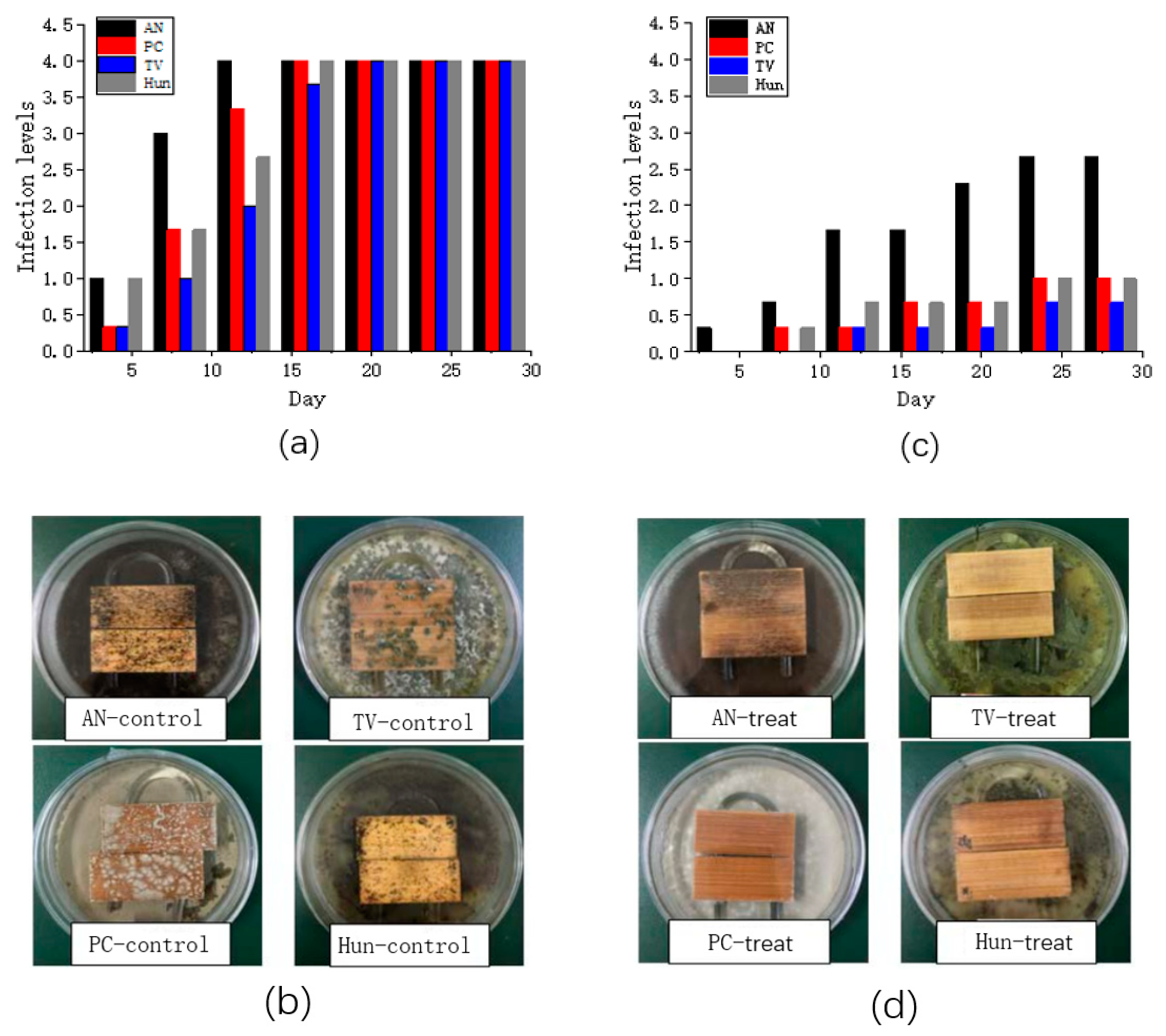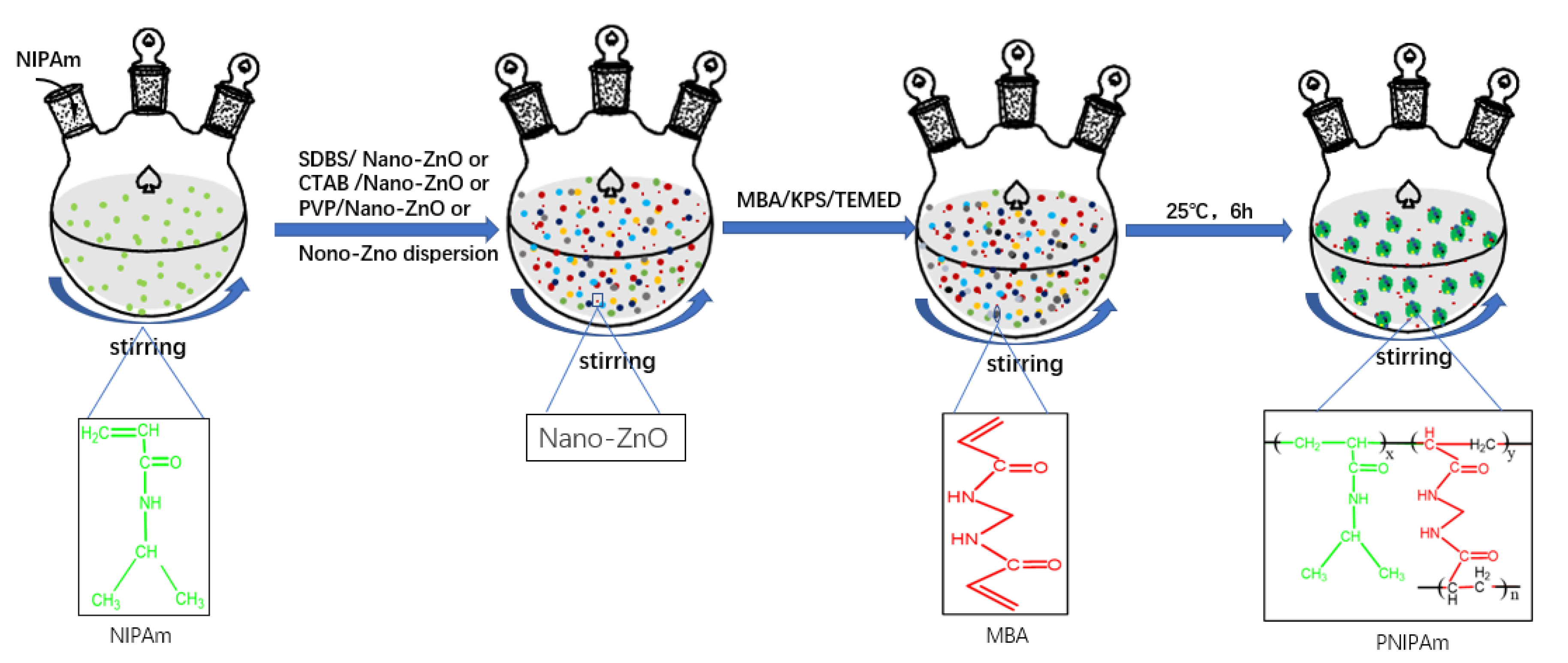Preparation and Anti-Mold Properties of Nano-ZnO/Poly(N-isopropylacrylamide) Composite Hydrogels
Abstract
:1. Introduction
2. Results and Analysis
2.1. FTIR Analysis
2.2. Dynamic Light Scattering (DLS) and Zeta Analysis
2.3. TEM Analysis
2.4. DSC Analysis
2.5. Anti-Mold Properties of Nano-ZnO/PNIPAm Composite Hydrogel Synthesized by the Addition of Nano-ZnO Dispersion(Pf)
3. Materials and Methods
3.1. Materials
3.2. Method
3.2.1. Preparation of Nano-ZnO/PNIPAm Composite Hydrogels
3.2.2. Fourier Transform Infrared (FTIR) Spectroscopy Analysis
3.2.3. Dynamic Light Scattering (DLS) Analysis
3.2.4. Zeta Potential Analysis
3.2.5. Transmission Electron Microscopy (TEM) Analysis
3.2.6. Differential Scanning Calorimetry (DSC) Analysis
3.2.7. Anti-Mildew Test
4. Conclusions
Author Contributions
Funding
Conflicts of Interest
References
- Gong, C.; Qi, T.; Wei, X.; Qu, Y.; Wu, Q.; Luo, F.; Qian, Z. Thermosensitive polymeric hydrogels as drug delivery systems. Curr. Med. Chem. 2012, 20, 79–94. [Google Scholar] [CrossRef]
- Wei, J.; Chen, Y.; Liu, H.; Du, C.; Yu, H.; Ru, J.; Zhou, Z. Effect of surface charge content in the TEMPO-oxidized cellulose nanofibers on morphologies and properties of poly(N-isopropylacrylamide)-based composite hydrogels. Ind. Crops Prod. 2016, 92, 227–235. [Google Scholar] [CrossRef]
- Yi, G.; Huang, Y.; Xiong, F.; Liao, B.; Yang, J.; Chen, X. Preparation and swelling behaviors of rapid responsive semi-IPN NaCMC/PNIPAm hydrogels. J. Wuhan Univ. Technol. 2011, 26, 1073–1078. [Google Scholar] [CrossRef]
- Zhuo, R.X.; Li, W. Preparation and characterization of macroporous poly(N-isopropylacrylamide) hydrogels for the controlled release of proteins. J. Polym. Sci. Pol. Chem. 2002, 41, 152–159. [Google Scholar] [CrossRef]
- Zhu, H.; Tao, J.; Wang, W.; Zhou, Y.; Li, P.; Li, Z.; Chu, P.K. Magnetic, fluorescent, and thermo-responsive Fe3O4/rare earth incorporated poly(St-NIPAM) core–shell colloidal nanoparticles in multimodal optical/magnetic resonance imaging probes. Biomaterials 2013, 34, 2296–2306. [Google Scholar] [CrossRef]
- Zhang, H.W.; Wang, L.Q.; Xiang, Q.F.; Zhong, Q.; Chen, L.M.; Xu, C.X.; Deng, D.Y.B. Specific lipase-responsive polymer-coated gadolinium nanoparticles for MR imaging of early acute pancreatitis. Biomaterials 2014, 35, 356–367. [Google Scholar] [CrossRef]
- Zhang, Z.; Wang, S.; Waterhouse, G.I.N.; Zhang, Q.; Li, L. Poly(N-isopropylacrylamide)/mesoporous silica thermosensitive composite hydrogels for drug loading and release. J. Appl. Polym. Sci. 2019, 137, 48391. [Google Scholar] [CrossRef]
- Makvandi, P.; Ali, G.W.; DellaSala, F.; Abdel-Fattah, W.I.; Borzacchiello, A. Biosynthesis and characterization of antibacterial thermosensitive hydrogels based on corn silk extract, hyaluronic acid and nanosilver for potential wound healing. Carbohyd. Polym. 2019, 223, 115023. [Google Scholar] [CrossRef]
- Xu, X.; Gu, Z.; Chen, X.; Shi, C.; Liu, C.; Liu, M.; Yang, B. An Injectable and Thermosensitive Hydrogel: Promoting Periodontal Regeneration by Controlled-Release of Aspirin and Erythropoietin. Acta. Biomater. 2019, 86, 235–246. [Google Scholar] [CrossRef]
- Madry, H.; Gao, L.; Rey-Rico, A.; Venkatesan, J.K.; Müller-Brandt, K.; Cai, X.; Cucchiarini, M. Thermosensitive hydrogel based on PEO–PPO–PEO poloxamers for a controlled in situ release of recombinant adeno-associated viral vectors for effective gene therapy of cartilage defects. Adv. Mater. 2019, 32, 1906508. [Google Scholar] [CrossRef] [Green Version]
- Tian, W.; Han, S.; Huang, X.; Han, M.; Cao, J.; Liang, Y.; Sun, Y. LDH hybrid thermosensitive hydrogel for intravaginal delivery of anti-HIV drugs. Artif. Cells. Nanomed. Biotechnol. 2019, 47, 1234–1240. [Google Scholar]
- Chen, Y.; Shi, J.; Zhang, Y.; Miao, J.; Zhao, Z.; Jin, X.; Ding, J. An injectable thermosensitive hydrogel loaded with an ancient natural drug colchicine for myocardial repair after infarction. J. Mater. Chem. B 2020, 8, 980–992. [Google Scholar] [CrossRef] [PubMed]
- Yu, P.; Xie, J.; Chen, Y.; Liu, J.; Liu, Y.; Bi, B.; Li, J. A thermo-sensitive injectable hydroxypropyl chitin hydrogel for sustained salmon calcitonin release with enhanced osteogenesis and hypocalcemic effects. J. Mater. Chem. B 2020, 8, 270–281. [Google Scholar] [CrossRef]
- Wei, J.G.; Chen, Y.F.; Du, C.G.; Liu, H.Z. Research progress in the applications of thermosensitive hydrogels in antibacterial field. Polymer Bulletin 2015, 12, 38–46. [Google Scholar] [CrossRef]
- Huang, Q.L.; Du, C.G.; Hua, Y.T.; Zhang, J.J.; Peng, R.; Yao, X.L. Synthesis and characterization of loaded Nano/zinc oxide composite hydrogels intended for anti-mold coatings on bamboo. Bioresources 2019, 14, 7134–7147. [Google Scholar] [CrossRef]
- Ma, J.Z.; Hui, A.P.; Liu, J.L. Progress of Nano-zinc oxide antibacterial materials. J. Funct. Mater. 2014, 45, 24001–24007. [Google Scholar] [CrossRef]
- Huang, Q.L.; Yu, H.L.; Du, C.G.; Zhou, Z.X.; Yao, X.L. Status of hanometer antibacterial hydrogel and application prospect in bamboo material mold-preservation. Chin. For. Prod. Ind. 2017, 44, 3–6. [Google Scholar] [CrossRef]
- Weng, Y.X.; Wu, K.Y. Bamboo mildew biology research III. The environmental conditions on the influence of bamboo mildew. For. Res. 1991, 4, 505–511. [Google Scholar]
- Kim, Y.S.; Liu, M.; Ishida, Y.; Ebina, Y.; Osada, M.; Sasaki, T.; Aida, T. Thermoresponsive actuation enabled by permittivity switching in an electrostatically anisotropic hydrogel. Nat. Mater. 2015, 14, 1002–1007. [Google Scholar] [CrossRef]
- Yu, Z.; Tang, D.; Lv, H.; Feng, Q.; Zhang, Q.; Jiang, E.; Wang, Q. Fabrication of thermo responsive fibrous ZnO/PNIPAM nanocomposites with switchable photocatalytic activity. Colloid Surface. A 2015, 471, 117–123. [Google Scholar] [CrossRef]
- Celebioglu, N.; Yilmaz, Y. Investigation of the luminescence, mechanical, and thermal properties of ZnO-entrapped poly(N-isopropyl acrylamide) gels. J. Compos. Mater. 2017, 51, 4079–4090. [Google Scholar] [CrossRef]
- Li, S.S.; Xu, J.G.; Shi, H.W.; Liu, C.; Xie, Y.; Wang, H.Y. Influence of dispersant on dispersibility of nano-ZnO. Clean Coal Technol. 2012, 5, 44–46. [Google Scholar] [CrossRef]
- Hunter, R.J. Zeta Potential in Colloid Science; Academic Press: Cambridge, MA, USA, 2013. [Google Scholar]
- Pang, J.S.; Zhang, H.Y.; Cao, B.; Song, C.W.; Mao, L.B.; Chen, J. Research on dispersion of ZnO nanoparticles in aqueous coating system. Bull. Chin. Ceram. Soc. 2009, 28, 108–112+116. [Google Scholar] [CrossRef]
- GB/T 18261-2013 Test Method for Anti-Mildew Agents in Controlling Wood Mould and Stain Fungi; Standardization Administration of China: Beijing, China, 2013; Available online: http://www.doc88.com/p-1816406664656.html (accessed on 10 October 2019).
Sample Availability: Samples of the compounds are available from the authors. |






| Name of Composite Hydrogel | Initial Particle Size/nm | Particle Size after Standing for 3 h/nm | Zeta Potential/mV |
|---|---|---|---|
| Pf | 130.5 | 174.2 | −15.94 |
| Ps | 246.5 | 280.0 | −4.13 |
| Pp | 493.4 | 1595.4 | 4.39 |
| No. | Abbreviation of the Composite Hydrogel | Dispersant Name | Dispersant Mass/g | Nano-ZnO Particle Mass/g | Nano-ZnO Dispersion Volume/μL |
|---|---|---|---|---|---|
| 1 | Pf | - | - | - | 300 |
| 2 | Ps | SDBS | 0.05 | 0.2 | - |
| 3 | Pc | CTAB | 0.1 | 0.2 | - |
| 4 | Pp | PVP | 0.1 | 0.2 | - |
| Infection Levels | Infected Area of Sample |
|---|---|
| 0 | No hyphae or mildew on the sample surface |
| 1 | Infected area of sample < 1/4 |
| 2 | Infected area of sample 1/4–1/2 |
| 3 | Infected area of sample 1/2–3/4 |
| 4 | Infected area of sample > 3/4 |
© 2020 by the authors. Licensee MDPI, Basel, Switzerland. This article is an open access article distributed under the terms and conditions of the Creative Commons Attribution (CC BY) license (http://creativecommons.org/licenses/by/4.0/).
Share and Cite
Zhang, J.; Huang, Q.; Du, C.; Peng, R.; Hua, Y.; Li, Q.; Hu, A.; Zhou, J. Preparation and Anti-Mold Properties of Nano-ZnO/Poly(N-isopropylacrylamide) Composite Hydrogels. Molecules 2020, 25, 4135. https://doi.org/10.3390/molecules25184135
Zhang J, Huang Q, Du C, Peng R, Hua Y, Li Q, Hu A, Zhou J. Preparation and Anti-Mold Properties of Nano-ZnO/Poly(N-isopropylacrylamide) Composite Hydrogels. Molecules. 2020; 25(18):4135. https://doi.org/10.3390/molecules25184135
Chicago/Turabian StyleZhang, Jingjing, Qiuli Huang, Chungui Du, Rui Peng, Yating Hua, Qi Li, Ailian Hu, and Junhui Zhou. 2020. "Preparation and Anti-Mold Properties of Nano-ZnO/Poly(N-isopropylacrylamide) Composite Hydrogels" Molecules 25, no. 18: 4135. https://doi.org/10.3390/molecules25184135







